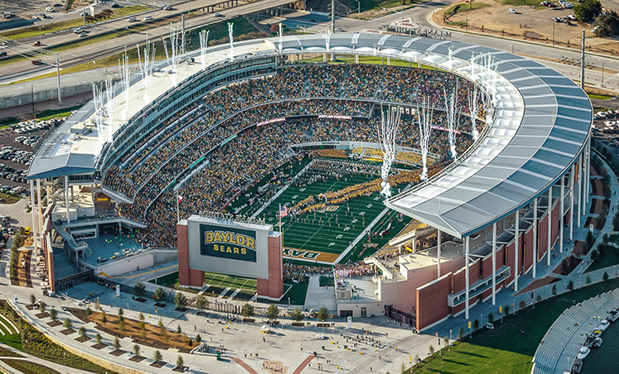According to a report by the National Climate Assessment, the frequency of "very heavy" precipitation has been on the rise for nearly 60 years. These events can be accompanied by high-speed, localized winds. The National Climate Assessment defines very heavy precipitation as a two-day precipitation total that is exceeded on average only once in a five-year period, also known as a once-in-five-year event. Since 1958, such heavy rain events have risen 71 percent in the Northeast, 37 percent in the Midwest and 27 percent in the South. In fact, since 1991, the amount of rain falling in very heavy precipitation events has been significantly above average, and increases in the frequency and intensity of such events are projected for all U.S. regions.
Such storms often result in the overloading of storm water drainage infrastructure and localized flooding around drains that cannot handle the amount of incoming water. However, the effects that microburst storms can have on roofs and roof drainage systems often are overlooked. Significant rainfall has led to significant damage of some buildings' plumbing systems and contributed to roof system failures. Roofs that incorporate roof drains should be inspected at least twice per year as well as after every major storm. However, for most companies, it seems such maintenance inspections are few and far between. Poor maintenance and blockages in drains and strainer domes have contributed to roof system failures and even roof collapses because of excessive amounts of water backing up on the roof.
It's in the code
The 2015 International Plumbing Code® includes performance-based criteria for roof drains. In prior code editions, drain selection exclusively was based on the pipe diameter of a building's plumbing system. However, a study conducted in 2012 by the American Society of Plumbing Engineers Research Foundation, with help from the International Association of Plumbing and Mechanical Officials, found roof drains of like sizes from different manufacturers (and even from the same manufacturers) did not necessarily perform at similar or even expected levels. In fact, 4-inch diameter roof drains tested were found to have flow rates, measured in GPM, or gallons per minute, anywhere from 180 to 754 GPM at a 4-inch head of water, which is quite a wide range.
This potentially was problematic because a typical 4-inch internal leader connected to a drain is not designed to accommodate elevated flow rates. Therefore, it's always a good idea for roof system designers to review drain choices and options with a design professional to confirm safety and compatibility with the applicable plumbing code.
Keep in mind that though it may not be clear how new code requirements will affect drain system design or roofing applications (such as new construction versus reroofing), it is clear there is a shift toward performance-based drain requirements. To this end, some manufacturers have initiated testing and evaluation programs geared toward offering products that meet changing requirements.
Who owns it?
Roof drainage has been discussed among roofing contractors for decades, and many contractors view it as part of a building's plumbing system.
But the reality is roofing and plumbing contractors alike should be familiar with the processes and components needed to safely and effectively remove water from roofs.
Upgrading or replacing roof drains also provides roofing contractors with an opportunity to increase their profits. The secret to doing this profitably is to find cost-effective, efficient ways to address roof drainage systems.
Examining the options
When it comes to roof drainage, roofing contractors essentially have four options:
- Do nothing
- Rework the drains
- Replace the drains
- Install an insert drain
Do nothing
Leaving an existing drain alone and untouched during reroofing is only an option on a small percentage of reroofing projects. This option only should be considered if the original equipment manufacturer drains in place are less than a few years old and in great shape with no visible damage, cracks or excessive rust.
Unfortunately, relatively new roofs fail from time to time. In situations where a newer roof was damaged in a major storm or wind event, the drains may be fine to leave alone. However, once drains have been on a roof for more than a few years, this likely is not a viable option.
Rework the drains
This option by far is the most common for roofing contractors, and on the surface, it sounds simple enough. The process may include drain cleaning and repainting, retapping and often replacing broken bolts, strainer domes and clamping rings. Reworking drains typically requires a host of tools—from drills, wire brushes, chisels and cleaning solvents to hammers and even pickaxes—and about two hours of time for each drain.
With better, more reliable options available, why is reworking drains the most common choice? The answer comes down to five main reasons:
- The perceived low cost of reworking existing drains
- Cost and time savings compared with installing new drains
- A lack of trust in backflow prevention mechanisms employed by insert drains
- Concerns that insert drains are too complicated
- The condition of the existing drains warrants a simple rework
To some, reworking drains may seem so fast it doesn't cost much. However, once you dig into the process, a different story typically unfolds. It may surprise you to learn it takes one laborer about two hours on average to properly rework a drain.
Let's examine the process: An experienced contractor's tools to rework drains include a pickax, hammer, wire brush, files, rags, powerful cleaning solutions, drill, drill bits, taps, spray paint, replacement nuts, bolts and washers.
If everything goes smoothly, this may be all that is required. But many drains found on roofs are 15 years old or older, especially if a roof has been reroofed several times. Old cast iron strainers, clamping rings and bowls can be extremely brittle, and if a proper pre-job inspection of each drain is not completed, surprises are likely in store.
Hairline cracks in strainers, clamping rings and drain bowls are inevitable. Broken strainer sections typically leave gaps in the dome that debris gets through, increasing the likelihood of clogging the drain and backing up onto the roof. Cracked drain bowls are a common source of leaks but frequently go unnoticed during the rework process.
If a proper inspection is completed, replacement components can be secured ahead of time to address this situation, but all too often such cracks result in an emergency search during less than ideal conditions followed by a trip to the plumbing supply store for repair materials. The question now becomes whether to replace just the broken components or all the drains to give it a more professional, uniform and updated look. And the cracked bowl still needs to be addressed.
Imagine there are 20 drains to rework on a job and each takes two hours to rework; that's 40 hours—a full week of time—that one laborer is tied up for the project, not to mention the effects this process can have on the reroofing work flow. Depending on the drain placement and how many squares per day your crew will complete, reworking a drain may require some sections of a roof not to be completed until drain work is finished.
Drain seal performance also has been an issue in years past. Before 2004, there was no industry standard that gave contractors peace of mind that a drain seal would work. In fact, many drains were "sealed" with rags, string and other materials that clearly were unsuitable for the job.
Many replacement drains now have seals that have been thoroughly tested in the market, and some meet ANSI/SPRI RD-1, "Performance Standard for Retrofit Roof Drains." The standard's test involves a drain holding a 10-foot column of water for 24 hours without leaking. Contractors always should look for these types of materials when considering drain options, particularly insert drain options.
The two hours needed for reworking drains does not include time spent obtaining necessary replacement parts, which is nearly impossible to estimate because the time will vary significantly based on the age and condition of existing drains. If the drains being reworked have been there for 15 years or longer, it's likely you simply won't know everything that needs to be fixed or replaced until you get well into the reworking process.
Replace the drains
Replacing rooftop drains typically involves evaluating new drain fixtures to ensure they meet code requirements and, as noted, a review by a design professional should be considered.
Replacing drains likely will require a plumber or mechanical contractor be subcontracted to do the work, which can lead to scheduling issues, project delays and increased insurance costs for the roofing contractor. If this is the case, make sure you work with a subcontractor who understands the hazards of working on a roof and has a good safety record.
Because replacing drains usually requires work on a roof deck's underside, it can be highly disruptive to building occupants. Accessing a roof deck's underside usually results in removing ceiling tiles, moving furniture and equipment, installing protective coverings for walls and carpets to protect against any water leaks that may occur during the process, and also may require work be completed after hours—an additional expense.
Install insert drains
Insert drains are designed to be installed directly over an existing drain bowl and into an existing leader. Years ago, many insert roof drains were fabricated by roofing contractors. Those drains were made out of anything a contractor had on hand, such as scrap sheet metal, copper or lead, and often had soldered and hand-rolled seams that split frequently. This led to leaks and damage to the roof or building.
Although not as common today, such drains definitely would fail to meet codes and standards, and because they lack a reliable mechanical seal, they would not pass the ANSI/SPRI RD-1 backflow pressure test.
Manufactured insert roof drains currently are the most widely used option. Most of these drains are made of aluminum, copper or construction-grade plastics. Strainer domes and clamping rings also may be made of construction-grade plastics, formed heavy sheet metal or cast aluminum. Cast aluminum domes are stronger than most plastics and weather better than cast iron. Also, aluminum will not rust and will provide a more aesthetically pleasing look during a roof system's life.
In addition, insert drains are available with flanges that are coated with TPO or PVC for faster, easier flashing without the need for clamping rings. During the past several years, such coated drains have become popular because roofing contractors are continually looking for even faster installation options to increase productivity on every project.
When evaluating a drain insert, it's a good idea to understand its installation, performance, typical flow rate in GPM, and whether it meets ANSI/SPRI RD-1 and plumbing code requirements.
In addition, the drain should have a mechanical seal that creates a perfectly symmetrical watertight connection with the drain leader and cannot be overtightened or undertightened during installation. Seal technology varies, but most seals are made from rubber or urethane materials and designed to meet or exceed ANSI/SPRI/RD-1.
Some manufactured retrofit drains can be installed by one person in five to 10 minutes with no tools. Such drains are by far faster and much less costly than complicated drains with removable seals. Because roofing contractors can install these drains without using subcontractors, they have more control over a project's schedule. In addition, all this work can be completed on the rooftop, which means contractors can complete a project without disturbing building occupants.
Historically, there have not been any code-based performance criteria for roof drains. Given the International Plumbing Code update that is evolving, and regardless of whether these changes will be adopted, it is clear some roof drain manufacturers are working to develop insert drains that meet target flow rates. As testing procedures and requirements are better determined, there likely will be an increase in the demand for roof drain performance data.
Profits and productivity
Replacing drains can help roofing contractors increase profits and improve efficiency, especially if they select the right drains. The best drains are easy and foolproof to install, don't require a subcontractor and minimize disruptions to building occupants.
More important, add-ons such as drains can help contractors build stronger relationships with building owners. Replacing drains in a cost-effective manner not only helps building owners save money, but it also could help them avoid leaks from cracked drain bowls or unknown flow rates of older reworked drains, leading to plumbing problems. And as most roofing contractors know, a satisfied customer is a returning customer.
Dan Genovese is product manager for OMG Roofing Products, Agawam, Mass.



